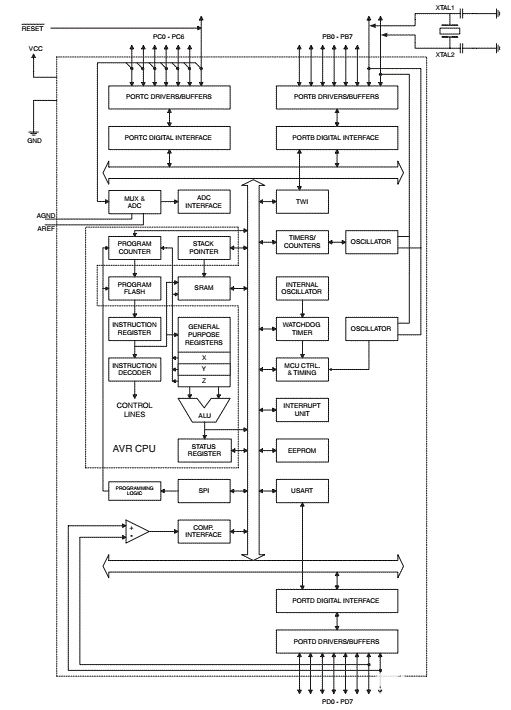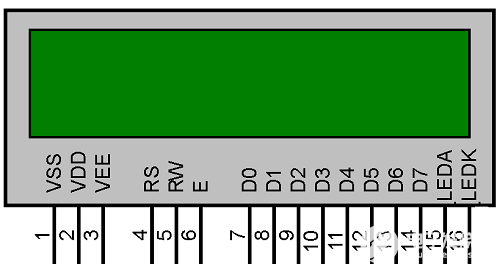ATtiny25 2K Bytes of In-System Self-Programmable Flash, 128 Bytes In-System Programmable EEPROM, 128 Bytes Internal SRAM. Two 8-bit timer/counters with PWM and prescaler, 10-bit ADC, USI-Universal Serial Interface. debugWIRE for on-chip-debug. Up to 20 MIPS throughput at 20 MHz. 1.8 - 5.5 V operation.
8KB version: ATtiny85
4KB version: ATtiny45
ATtiny26 2K Flash Program Memory, 128 Bytes SRAM, 128-Byte EEPROM, 11-Channel 10-bit A/D converter. Universal Serial Interface. High Frequency PWM. Up to 16 MIPS throughput at 16 MHz.
ATtiny28L 2K Flash Program Memory, 32 bytes register file, Keyboard interrupt, high-current LED driver, Analog Comparator. Up to 4 MIPS throughput at 4 MHz.
ATtiny44 4K Bytes of In-System Self-Programmable Flash, 256 Bytes In-System Programmable EEPROM, 256 Bytes Internal SRAM. 8-bit and 16-bit timer/counters with PWM, 10-bit ADC, USI-Universal Serial Interface, On-chip Temperature Sensor. debugWIRE for on-chip-debug. Up to 20 MIPS throughput at 20 MHz. 1.8 - 5.5 V operation.
8KB version: ATtiny84
2KB version: ATtiny24
ATtiny45 4K Bytes of In-System Self-Programmable Flash, 256 Bytes In-System Programmable EEPROM, 256 Bytes Internal SRAM. Two 8-bit timer/counters with PWM and prescaler, 10-bit ADC, USI-Universal Serial Interface. debugWIRE for on-chip-debug. Up to 20 MIPS throughput at 20 MHz. 1.8 - 5.5 V operation.
8KB version: ATtiny85
2KB version: ATtiny25
ATtiny84 8K Bytes of In-System Self-Programmable Flash, 512 Bytes In-System Programmable EEPROM, 512 Bytes Internal SRAM. 8-bit and 16-bit timer/counters with PWM, 10-bit ADC, USI-Universal Serial Interface, On-chip Temperature Sensor. debugWIRE for on-chip-debug. Up to 20 MIPS throughput at 20 MHz. 1.8 - 5.5 V operation.
4KB version: ATtiny44
2KB version: ATtiny24
ATtiny85 8K Bytes of In-System Self-Programmable Flash, 512 Bytes In-System Programmable EEPROM, 512 Bytes Internal SRAM. Two 8-bit timer/counters with PWM and prescaler, 10-bit ADC, USI-Universal Serial Interface. debugWIRE for on-chip-debug. Up to 20 MIPS throughput at 20 MHz. 1.8 - 5.5 V operation.
4KB version: ATtiny45
2KB version: ATtiny25
This applies to all types of AVR microcontrollers because they all use same AVR core technology. So lets go through some of them:
Ability to work at 1MIPS/MHz (MIPS – Millions Instructions Per Second);
On chip Flash memory (now tiny series have up to 8kB, mega up to 256kB) with write cycle not less than 1000 times;
On chip RAM memory (tiny series up to 512B, mega up to 8kB);
On chip EEPROM memory (tiny series up to 512B, mega up to 4kB) with write cycle not less than 100000 times;
Working frequencies up to 20MHz;
Protection fuses from unintentional reading and modification of program and data memories;
Ability to program in system – directly on board using ISP cable;
Four types of clock generators: Internal generator, RC generator of clock cycles, Internal generator with external crystal resonator, and External synchronisation;
Two or three power down modes;
Some microcontroller can work at very low voltages like 1.8V;
Other internal processor properties:
Static architecture where minimal frequency equal to zero;
ALU is connected directly to general purpose registers;
Most of commands are performed in one clock cycle;
Multilevel system of interrupts;
Many sources of interrupts – two of them are external;
Three level hardware stack.
I/O system properties:
Software configurable and selection of I/O ports;
Ports can be programmed as inputs and outputs independently to each other;
Input buffers uses Smith triggers on all pins;
Support of Internal Pull-Up resistors (about 35 to 120kOhm);
Peripheral devices vary from device to device. Refer to datasheets to find out what peripherals are included in concrete model. In general we can mention:
8 bit timer counter with pre-scaler;
16 bit timer counter with pre-scaler ;
Watch dog timer;
PWM generator;
Analog comparator;
ADC;
Hardware modulator;
SPI interface;
TWI (I2C) interface;
UART;
For additional information refer to datasheets.
 電子發(fā)燒友App
電子發(fā)燒友App






















評論